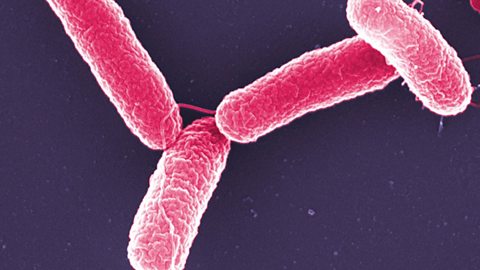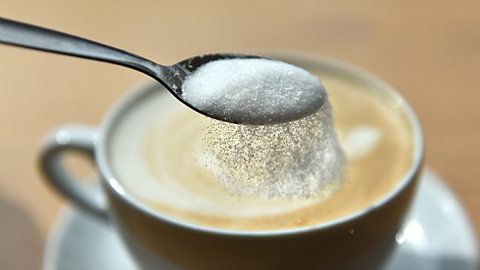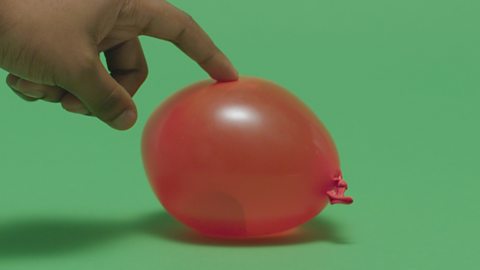Key points
- The leaf is one of the most important organs of a plant.
- Leaves produce food for the plant through a process called photosynthesis.
- The leaves of different plants vary widely in size, shape and colour and are adapted to carry out photosynthesis.
Leaves and photosynthesis
Video - Leaf structure
Ms Armit: The leaf is a major organ in plants in which photosynthesis occurs. Without photosynthesis, there'd be very little life on Earth, because when plants photosynthesise, they take in carbon dioxide, and release oxygen as a by-product.
Cal: I am liking plants a lot right now, so let's find out more on how the structures of leaves help plants to photosynthesise.
VOICEOVER: Leaves come in all shapes and sizes, depending on the environment they have evolved in.The green of the leaf is the chlorophyll, the pigment that absorbs energy from the sun. Some plants have evolved with large leaves to maximise the amount of light they can absorb, often found under forest canopies where they struggle for exposure to light.
The cross-section of a leaf reveals its complex structure. The waxy cuticle surface on the outside protects the leaf and prevents excess water loss. The palisade cells at the upper side are packed with chloroplasts to maximise photosynthesis. On the lower half of the leaf are spongy mesophyll cells. These have air spaces between them to let gases flow. The stomata - tiny openings or pores – allow gases such as carbon dioxide and oxygen in or out during photosynthesis and respiration.
Leaves are important for life to exist on Earth. They provide food and oxygen for almost every living organism on our planet.
Cal: Welcome back to the jungle!
Ms Armit: What have you done?
Cal: Well, you inspired me. You know, we all know plants are amazing, and without photosynthesis we wouldn't be here. So, of course, we have to show our appreciation to plants.
Ms Armit: I'm so glad you've found a new passion. Have a look at the leaves of your new friend.
Cal: I mean… Yeah, they're good, aren't they? I mean, they feel a little bit waxy, almost.
Ms Armit: That's the waxy cuticle. It's on the surface of the leaf and its main job is to prevent water loss as the plant needs this water. It also protects the plant. See what happens when you pour water all over the leaf.
Cal: Oh, right. OK. Would you believe it? Got my watering can here. OK.
Oh, so it's like staying on top of the leaf there. So that must be because of the waxy layer - the cuticle.
Ms Armit: Precisely. Another very important part of the leaf are the palisade cells. These are full of chloroplasts to absorb sunlight. Where in the leaf do you think the palisade cells are?
Cal: If they've got all those chloroplasts, then you'd need them to be near the top of the leaf to get that all-important sunshine.
Ms Armit: That's right. Palisade cells are at the top of the leaves to maximise photosynthesis. This is one of the adaptations of leaves so that they maximise the amount of light they absorb for photosynthesis. Another adaptation of the plant leaves is the waxy cuticle.
Cal: That is very cool.
Ms Armit: There's more. If you were to zoom in really close to your leaves, you'd find loads of these tiny holes. These are called stomata.
Cal: Right, now, I'm not I'm not saying that I don't trust you, Ms Armit, because I do, but I can't see it. So I can't be certain that those tiny holes are actually there.
Ms Armit: This is something I can prove, though, with some nail varnish.
Cal: Oh, would you believe it? I've got some here. You know?
Ms Armit: You're going to put some that nail varnish on both sides of your leaf.
Cal: OK. Right. I'll do this one here. So I'll put some on that side. Put some on the other side, like that. So is this what people mean by a well-manicured plant?
Ms Armit: Ha-ha. Leave that one to dry. There's one already over there that's done. Going to go and peel off some of the nail polish and tell me what you see.
Cal: OK. Right. My Blue Peter moment. Here's one I made earlier. Um… OK. So some nail varnish here, I'm going to pull it off. I mean, it looks like really… really bumpy.
Oh, you were right. So my plant does have stomata.
Ms Armit: I told you. If you had a microscope, you would be able to see this even better. The stomata allows gases to flow in and out of the leaves.
Cal: Which is perfect for photosynthesis, as it takes in carbon dioxide and produces oxygen.
Ms Armit: But plants don't just photosynthesise, they also respire.
Cal: What, respire like us?
Ms Armit: Yeah. During the day and night, the plants are constantly respiring to release the energy in glucose so they can live - just like you. It's only during the day that plants photosynthesise. Any idea why?
Cal: Because the sun is only out in the day.
Ms Armit: Exactly.
Cal: Yes!
photosynthesisA chemical reaction that occurs in the chloroplasts of plants in which the energy in light is stored in glucose. is a vital process that occurs in the leaves of a plant. During photosynthesis, the leaves use chlorophyllGreen pigment found within chloroplast that enables the process of photosynthesis to occur. and light energy to convert carbon dioxide and water into oxygen and glucose. The glucose acts as a source of food for the plant.
The equation for photosynthesis is:
Carbon dioxide + water → glucose + oxygen
Adaptations for photosynthesis
Leaves have several adaptations which play an important role in photosynthesis.
| Plant adaptation | Function |
|---|---|
| Broad leaves | Provide a large surface area to absorb as much sunlight as possible. |
| Thin leaves | Provide a short diffusionThe overall movement of particles of gas or liquid from an area of higher to lower concentration. pathway for gases to move into and out of cells. |
| Network of tubes (xylem and phloem) | To transport water, mineral ions and glucose (food) around the plant. |
| Lots of chloroplast | Contain a green substance called chlorophyll, which traps energy from the sun for photosynthesis. |
| Stomata | Tiny holes found mainly underneath the leaf to allow gases to diffuse into and out of the leaf. Each hole is a single stoma. |
| Guard cells | Controls the opening and closing of stomata. |
| Midrib | Provides strength throughout the leaf, keeping it upright and sturdy in the wind. |
| Petiole | Attaches the leaf to the stem. |
Light
A leaf usually has a large surface area, so that it can absorb a lot of light. Its top surface is protected from water loss, disease and weather damage by a waxy layer.
The upper part of the leaf is where the light falls, and it contains a type of cell called a palisade cell. This is adapted to absorb a lot of light. It has lots of chloroplasts and is shaped like a tall box.
Carbon dioxide
Plants get the carbon dioxide they need from the air through their leaves. It moves by diffusion through small holes in the underside of the leaf called stomata. Guard cells control the size of the stomata so that the leaf does not lose too much water in hot, windy or dry conditions.
The lower part of the leaf is a spongy layer with loose-fitting cells. These let carbon dioxide reach the other cells in the leaf due to the air spaces around them, and also let the oxygen produced in photosynthesis leave the leaf easily.
Water
The water needed for photosynthesis is absorbed through the roots and transported through tubes to the leaf.The roots have a type of cell called a root hair cell. These project out from the root into the soil, and have a big surface area and thin walls. This lets water pass into them easily.
Root cells do not contain chloroplasts, as they are normally in the dark and cannot carry out photosynthesis.
Video - Parts of the leaf
Watch the video to see how a horticulturist uses science in her job
My name is Katie I work at the Eden Project, and I'm a skilled horticulturist. I work in the outside gardens.
A horticulturist is someone that looks after the plants through their life cycle, we'll feed them and water them, train them or prune them as they get too big.
Leaves come in all different shapes and sizes. They all have the same basic setup. All leaves are used for photosynthesising in a plant, and that feeds the plant. You've got the midrib, and the veins, and the edge, and the leaf stem, which is called the petiole.
Different plants from different parts of the world have different adaptations to help them conserve water. This plant is really well adapted to the Mediterranean climate where it doesn't rain very much, so it's got these leaf hairs which helps capture that water.All the leaves in the rainforest are really, really big. They're trying to utilise the sunlight which there's very little of 'cause there's so many plants everywhere.
You can see here, there's holes in the leaf, and with a lot of air moving from the waterfall, these holes stop the leaf from ripping.My love for plants comes from when I was a child, I'd love being outdoors, I enjoyed science loads at school 'cause it was far more practical, you got to look at things, you got to look at plants and animals. It just seemed more applicable to life.
Can you answer these questions based on the video?
1. What is a horticulturist?
2. What are the four main features of a leaf which are mentioned in the video?
An expert who looks after plants, including feeding, watering, pruning and training. They must also have extensive knowledge about trees, flowers, vegetables, nuts, bushes and fruits.
Midrib, Veins, Edge, Petiole.
The importance of leaves
Leaves provide food for plants, and plants provide the food for all living organisms on Earth. Without plants, all other food chains would cease to exist.
Some leaves also have medicinal uses, for example the leaves of the snapdragon plant are used to reduce fever and inflammation.Knowledge of leaves is also important to horticulturists. They need to know the best conditions for different types of plants in order to grow flowers, fruit and vegetables.
Botany is the study of plants and botanistAn expert in the scientific study of plants. are scientists who need to understand how plants relate to other organisms and the biodiversityA measure of the range of living organisms within a habitat. of an area. For example, botanists may learn about how to classify and protect plants, which in turn can provide us with the knowledge to develop new medicines. The more we know about botany, the more we understand about life on Earth.
Test your knowledge
Label the leaf
Quiz
GCSE exam dates 2025
Find out everything you need to know about the 2025 GCSE exams including dates, timetables and changes to exams to get your revision in shape.

More on Living organisms
Find out more by working through a topic
- count11 of 15

- count12 of 15

- count13 of 15

- count14 of 15
